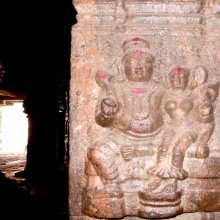Riti, Rīti, Riṭi, Ṛti: 21 definitions
Introduction:
Riti means something in Hinduism, Sanskrit, Marathi, Hindi, Tamil. If you want to know the exact meaning, history, etymology or English translation of this term then check out the descriptions on this page. Add your comment or reference to a book if you want to contribute to this summary article.
The Sanskrit term Ṛti can be transliterated into English as Rti or Riti, using the IAST transliteration scheme (?).
Images (photo gallery)
(+7 more images available)
In Hinduism
Ayurveda (science of life)
Rasashastra (Alchemy and Herbo-Mineral preparations)
Source: Wisdom Library: Rasa-śāstraṚti (ऋति) is the Sanskrit word translating to “brass”, a metal alloy made of zinc and copper. It is used throughout Rasaśāstra literature, such as the Rasaprakāśasudhākara.

Āyurveda (आयुर्वेद, ayurveda) is a branch of Indian science dealing with medicine, herbalism, taxology, anatomy, surgery, alchemy and related topics. Traditional practice of Āyurveda in ancient India dates back to at least the first millenium BC. Literature is commonly written in Sanskrit using various poetic metres.
Purana and Itihasa (epic history)
Source: archive.org: Shiva Purana - English TranslationRīti (रीति) refers to the “customary procedures (of the marriage)”, according to the Śivapurāṇa 2.3.29 (“Śivā-Śiva dialogue”).—Accordingly, as Pārvatī said to Śiva: “[...] The planets were not worshipped by my father. Therefore a great defect occurred in our marriage in regard to the planets. Hence, O lord, you will celebrate marriage in accordance with the rules for the fulfilment of the task of the gods. The customary procedures (rīti) of the marriage shall certainly be followed. Let Himavat know that an auspicious penance has been performed well by his daughter”.
Source: Cologne Digital Sanskrit Dictionaries: The Purana IndexRiṭi (रिटि).—A head of a Śiva gaṇa.*
- * Brahmāṇḍa-purāṇa III. 41. 28.

The Purana (पुराण, purāṇas) refers to Sanskrit literature preserving ancient India’s vast cultural history, including historical legends, religious ceremonies, various arts and sciences. The eighteen mahapuranas total over 400,000 shlokas (metrical couplets) and date to at least several centuries BCE.
Kavya (poetry)
Source: Shodhganga: A critical appreciation of soddhalas udayasundarikathaRīti (रीति).—Vānana boldly asserts that rīti is the soul of poetry, that rīti consists in the special arrangement in combination of words and the speciality lies in the possession of Guṇas. Vānana gives only the Vaidarbhī, the Pāñcālī and the Gauḍīya. Bhoja adds Lātiya, Āvantī and Māgadhī.
Soḍḍhala who flourished after Rājaśekhara also follows him in the matter of three Ritis, namely Vaidarbhī, Pāñcālī and the Gauḍīya but he introduces a new idea not found elsewhere viz. the idea of the three rītis considered as corresponding to theethree qualities of voices, belonging to the cuckoo, the peacock and the swan.

Kavya (काव्य, kavya) refers to Sanskrit poetry, a popular ancient Indian tradition of literature. There have been many Sanskrit poets over the ages, hailing from ancient India and beyond. This topic includes mahakavya, or ‘epic poetry’ and natya, or ‘dramatic poetry’.
Natyashastra (theatrics and dramaturgy)
Source: Shodhganga: Mankhaka a sanskrit literary genius (natya)Rīti (रीति, “style”) is one of the important measuring rods for the poets. This is an indispensable characteristic feature of a poem. Viśvanātha Kavirāja opines that the arrangement of words or syllables, which render help in heightening the excellence of rasa or the sentiment, is regarded as rīti. Rīti, is as if, the adjustment of body parts of an individual. In his Kāvyālaṃkārasūtravṛtti, Vāmana, the rhetorician states that the particular style of arrangement of words is known by the term rīti. It is the very essence or ātmā of poetry.
This rīti is of different types. Regarding the variety of rīti, the poeticians are of divergent opinions. Bharata (Nāṭyaśāstra VI.25-26) refers to five types of rīti. The Agnipurāṇa (adhyāya 340) speaks of four kinds of rīti. Bhāmaha (Kāvyālaṃkāra I.35) mentions about Vaidarbhī and Gauḍī and puts more importance upon Gauḍī. Daṇḍin (Kāvyādarśa II.9) accepts only two varieties of rīti viz. Vaidarbhī and Gauḍī and favours Vaidarbhī. Again, Vāmana (Kāvyālaṃkārasūtravṛtti 2.9) as well as Rājaśekhara (Kāvyamīmāṃsā, p. 10) mentions three kinds of rīti viz. Vaidarbhī, Gauḍī or Gauḍīyā and Pāñcālī. Moreover, Rudraṭa, in his Kāvyālaṃkāra, Viśvanātha Kavirāja (Sāhityadarpaṇa IX.1-2) also, mentions four kinds of rīti, referring to Lāṭī or Lāṭikā to be the fourth one. Bhoja, in Sarasvatīkaṇṭhābharaṇa says about six types of rīti, adding two more viz. Āvantikā and Māgadhī.
It may be mentioned here that according to Mammaṭa and Ānandavardhana the term, rīti and vṛtti are synonymous. Regarding the characteristics of the above four styles, some opine that the Gauḍī is a grand composition, the Vaidarbhī is sweet, the Pāñcālī is mixed, while, the Lāṭī is composed of simple words.

Natyashastra (नाट्यशास्त्र, nāṭyaśāstra) refers to both the ancient Indian tradition (shastra) of performing arts, (natya—theatrics, drama, dance, music), as well as the name of a Sanskrit work dealing with these subjects. It also teaches the rules for composing Dramatic plays (nataka), construction and performance of Theater, and Poetic works (kavya).
Kavyashastra (science of poetry)
Source: Shodhganga: Bhismacaritam a critical studyRīti (रीति, “dictions”) refers to the “soul of property”, as employed in the Bhīṣmacarita (Bhishma Charitra) which is a mahākāvya (‘epic poem’) written by Hari Narayan Dikshit.— The definition of the concept of rīti was given for the first time by Vāmana and who described it as a peculiar arrangement of words. In other words of Viśvanātha, the rīti assists the realization of sentiment, just as the structure of body assists the soul. According to Vāmana, ‘rīti’ is the soul of property. It is the essence of language which cannot be separated from it in any case. [...]
About the types of the rīti there are many views of the Ācāryas but the minimum number is three which is accepted by most of the Ācāryas. They are the:—
- vaidarbhī,
- gauḍī,
- pāñcālī.
As regards the ‘rīti’ (diction) of Bhīṣmacarita is concerned, it is necessary to remember that the diction of ‘rīti’ changes according to the subject-matter, characterization and descriptions in a mahākāvya. If a love-scene is to be described, the language is of necessity, simple, spontaneous and sweet but on the other hand, in the descriptions of the battle-scenes, language becomes harsh, complicated and terse. A mahākāvya can achieve the greatest height of artistic composition only if a proper ‘rīti’ is employed at the proper place. Thus, multiplicity of ‘rītis’ in an artistic composition is inevitable and same is the case with the ‘rīti’ of Hari Narayan. He is a double-stylist personality and uses both rītis (viz. vaidarbhī and gauḍī) according to the suitability of the context.

Kavyashastra (काव्यशास्त्र, kāvyaśāstra) refers to the ancient Indian tradition of poetry (kavya). Canonical literature (shastra) of the includes encyclopedic manuals dealing with prosody, rhetoric and various other guidelines serving to teach the poet how to compose literature.
Vastushastra (architecture)
Source: Shodhganga: Elements of Art and Architecture in the Trtiyakhanda of the Visnudharmottarapurana (vastu)Rīti (रीति) or “rust of iron” is used as an ingredient of a mixture of Vajralepa (“a special kind of hard cement”) which was used in the construction of a Temple and as a binding agent for joining bricks, according to the Viṣṇudharmottarapurāṇa, an ancient Sanskrit text which (being encyclopedic in nature) deals with a variety of cultural topics such as arts, architecture, music, grammar and astronomy. In the Viṣṇudharmottarapurāṇa, five procedures of preparing the vajralepa are suggested.—The fourth kind of vajralepa is made by the mixture of some metals [e.g., two parts of rīti i.e., rust of iron]. It is seen that the portions of the metals, suggested in the Bṛhatsaṃhitā are similar as stated in the Viṣṇudharmottarapurāṇa.

Vastushastra (वास्तुशास्त्र, vāstuśāstra) refers to the ancient Indian science (shastra) of architecture (vastu), dealing with topics such architecture, sculpture, town-building, fort building and various other constructions. Vastu also deals with the philosophy of the architectural relation with the cosmic universe.
General definition (in Hinduism)
Source: Triveni: The Philosophy of RitiRiti (“the Soul of a Kavya”):—Riti is to the Kavya what Atman is to the Sarira. The word Atman is believed to have been derived from the root ‘At’ meaning to move constantly or from the root ‘An’ meaning to live, or perhaps from both. The term Riti is derived from the root ‘Ri’ meaning to move. The identity of Riti with Atman becomes complete when we take Dandin’s metaphor of Gunas as Pranas. Just as the Atman is the Karana Sarira of a person, Riti is the Karana Sarira of a Kavya. The natural beauty or Sobha of a Kavya depends on the Gunas of its Soul which is Riti.
Out of Riti arise the Gunas, the Pranas or directional forces round which the subtle and gross materials organize themselves. Since Riti, like the Atman, is a having and moving principle, it imparts life and movement to the subtle and gross bodies of the Kavya. Thus Riti determines the character of a Kavya as the Atman determines the character of an individual.
Languages of India and abroad
Marathi-English dictionary
Source: DDSA: The Molesworth Marathi and English Dictionaryrīti (रीति).—f (S) pop. rīta f A manner, method, way. 2 Custom, habit, practice, habitual action. 3 Fashion, popular usage, general course, local observance.
Source: DDSA: The Aryabhusan school dictionary, Marathi-Englishrīti (रीति).—f A manner; habit, custom; fashion.
Marathi is an Indo-European language having over 70 million native speakers people in (predominantly) Maharashtra India. Marathi, like many other Indo-Aryan languages, evolved from early forms of Prakrit, which itself is a subset of Sanskrit, one of the most ancient languages of the world.
Sanskrit dictionary
Source: DDSA: The practical Sanskrit-English dictionaryṚti (ऋति).—[ṛ-ktin] An army. -f.
1) Going, motion.
2) Assault, combat; ऋतिर्हन्यमाना (ṛtirhanyamānā) Av.12.5.25.
3) Abuse, censure.
4) Emulation, envy.
5) A road.
6) Manner of proceeding.
7) Prosperity.
8) Fitness, truth.
9) Remembrance.
1) Misfortune.
11) Protection.
12) Auspiciousness (most of these meanings are found only iu lexicons).
Derivable forms: ṛtiḥ (ऋतिः).
--- OR ---
Riṭi (रिटि).—
1) The crackling of flames.
2) Black salt.
3) A musical instrument.
4) Name of an attendant of Śiva; cf. भृङ्ग (bhṛṅga) (ge) रिटिः (riṭiḥ).
Derivable forms: riṭiḥ (रिटिः).
--- OR ---
Rīti (रीति).—f. [rī-ktin]
1) Moving, flowing.
2) Motion, course.
3) A stream, river.
4) A line, boundary.
5) A method, mode, manner, way, fashion, course, general way; रीतिं गिराममृतवृष्टिकरीं तदीयाम् (rītiṃ girāmamṛtavṛṣṭikarīṃ tadīyām) Bv.3.19; पुत्रादपि धनभाजां भीतिः सर्वत्रैषा विहिता रीतिः (putrādapi dhanabhājāṃ bhītiḥ sarvatraiṣā vihitā rītiḥ) Moha M.2; उक्तरीत्या, अनयैव रीत्या (uktarītyā, anayaiva rītyā) &c.
6) Usage, custom, practice.
7) Style, diction; पदसंघटना रीतिरङ्गसंस्थाविशेषवत् । उपकत्रीं रसादीनां सा पुनः स्याच्चतुर्विधा ॥ वैदर्भी चाथ गौडी च पाञ्चाली लाटिका तथा (padasaṃghaṭanā rītiraṅgasaṃsthāviśeṣavat | upakatrīṃ rasādīnāṃ sā punaḥ syāccaturvidhā || vaidarbhī cātha gauḍī ca pāñcālī lāṭikā tathā) | S. D.624-5.
8) Brass, bell-metal; (rītī also in this sense).
9) Rust of iron.
1) The oxide formed on the surface of metals.
11) Calx of brass.
12) Natural property or disposition.
Derivable forms: rītiḥ (रीतिः).
Source: Cologne Digital Sanskrit Dictionaries: Shabda-Sagara Sanskrit-English DictionaryṚti (ऋति).—f.
(-tiḥ) 1. Prosperity, felicity. 2. A road, a way. 3. Abuse, censure, reproach. 4. Envy, emulation. 5. Going, motion. 6. Ill fortune. E. ṛ and ktin aff.
--- OR ---
Riṭi (रिटि).—f.
(-ṭiḥ) 1. The crackling or roaring of flame. 2. A musical instrument. 3. Black-salt. m.
(-ṭiḥ) Name of an attendant of Siva.
--- OR ---
Rīti (रीति).—f. (-tiḥ-tī) 1. Usage, custom, practice, local or traditionary observance. 2. Oozing, leaking, distilling. 3. Brass, pale-brass, or prince’s metal. 4. Rust of iron. 5. Calx of brass. 6. Scoria of any metal, or the oxide formed on the surface of metals by their exposure to heat and air. 7. Boundary, limit. 8. Going, motion. 9. Natural property or disposition. 10. A stream, a river. 11. Style, diction; they are:—vaidarbhī, gauḍī, pāñcālī and lāṭikā or māgadhī . E. rī to go, to run out, &c. aff. ktic .
Source: Cologne Digital Sanskrit Dictionaries: Benfey Sanskrit-English DictionaryṚti (ऋति).—[ṛ + ti], f. 1. Way, Lass, 2, 8. 2. Attack (ved.).
--- OR ---
Rīti (रीति).—[rī + ti], f. 1. Going. 2. Boundary. 3. Usage, manner, way, [Lassen, Anthologia Sanskritica.] 2. ed. 2, 6. 4. Natural property. 5. Oozing. 6. Brass, pale brass. 7. Calx of brass. 8. Rust of iron.
Source: Cologne Digital Sanskrit Dictionaries: Cappeller Sanskrit-English DictionaryṚti (ऋति).—[feminine] onset, struggle.
--- OR ---
Ṛti (ऋति).—[feminine] onset, struggle.
--- OR ---
Rīti (रीति).—[feminine] going, motion, course, stream; line, row; way, manner; style, diction.
Source: Cologne Digital Sanskrit Dictionaries: Monier-Williams Sanskrit-English Dictionary1) Ṛti (ऋति):—[from ṛ] ṛti or ṛti f. going, motion, [cf. Lexicographers, esp. such as amarasiṃha, halāyudha, hemacandra, etc.]
2) [v.s. ...] assault, attack ([Boehtlingk & Roth’s Sanskrit-Woerterbuch]), [Atharva-veda xii, 5, 25; Vājasaneyi-saṃhitā xxx, 13]
3) [v.s. ...] envy, emulation, [cf. Lexicographers, esp. such as amarasiṃha, halāyudha, hemacandra, etc.]
4) [v.s. ...] reproach, abuse, [cf. Lexicographers, esp. such as amarasiṃha, halāyudha, hemacandra, etc.]
5) [v.s. ...] path, way, [cf. Lexicographers, esp. such as amarasiṃha, halāyudha, hemacandra, etc.]
6) [v.s. ...] prosperity, felicity, [cf. Lexicographers, esp. such as amarasiṃha, halāyudha, hemacandra, etc.]
7) [v.s. ...] aversion, [cf. Lexicographers, esp. such as amarasiṃha, halāyudha, hemacandra, etc.]
8) [v.s. ...] remembrance, memory, [cf. Lexicographers, esp. such as amarasiṃha, halāyudha, hemacandra, etc.]
9) [v.s. ...] protection, [cf. Lexicographers, esp. such as amarasiṃha, halāyudha, hemacandra, etc.]
10) [v.s. ...] misery, [cf. Lexicographers, esp. such as amarasiṃha, halāyudha, hemacandra, etc.]
11) [v.s. ...] pain, [Tārānātha tarkavācaspati’s Vācaspatyam, Sanskrit dictionary]
12) [v.s. ...] (is) m. Name of a god to be worshipped by human sacrifice, [Vājasaneyi-saṃhitā xxx, 13] ([Tārānātha tarkavācaspati’s Vācaspatyam, Sanskrit dictionary])
13) [v.s. ...] an assailant, enemy, [Atharva-veda xii, 5, 25] ([Tārānātha tarkavācaspati’s Vācaspatyam, Sanskrit dictionary])
14) Ṛtī (ऋती):—[from ṛ] (in [compound] for ṛti above).
15) Riṭi (रिटि):—f. (only [cf. Lexicographers, esp. such as amarasiṃha, halāyudha, hemacandra, etc.]) the crackling or roaring of flames
16) a musical instrument
17) black salt (cf. bhṛṅgiand bhṛṅgī-r).
18) Rīti (रीति):—[from ri] f. going, motion, course, [Ṛg-veda]
19) [v.s. ...] a stream, current, [ib.]
20) [v.s. ...] a streak, line, row, [Pāraskara-gṛhya-sūtra; Harivaṃśa; Naiṣadha-carita]
21) [v.s. ...] limit, boundary (= sīman), [cf. Lexicographers, esp. such as amarasiṃha, halāyudha, hemacandra, etc.]
22) [v.s. ...] general course or way, usage, custom, practice, method, manner, [Kāvya literature; Kathāsaritsāgara; Sarvadarśana-saṃgraha]
23) [v.s. ...] natural propensity or disposition, [cf. Lexicographers, esp. such as amarasiṃha, halāyudha, hemacandra, etc.]
24) [v.s. ...] style of speaking or writing, diction (three are usually enumerated, viz. vaidarbhī, gauḍī, pāñcālī, to which a fourth is sometimes added, viz. lāṭikā, and even a fifth and sixth, viz. āvantikā or yāvantikā and māgadhī), [Vāmana’s Kāvyālaṃkāravṛtti; Kāvyādarśa; Sāhitya-darpaṇa] etc.
25) [v.s. ...] yellow or pale brass, bell-metal, [Rājataraṅgiṇī; Kathāsaritsāgara]
26) [v.s. ...] rust of iron, [cf. Lexicographers, esp. such as amarasiṃha, halāyudha, hemacandra, etc.]
27) [v.s. ...] scoria or oxide formed on metals by exposure to heat and air, [cf. Lexicographers, esp. such as amarasiṃha, halāyudha, hemacandra, etc.]
28) Rīṭi (रीटि):—See bhṛṅgirīṭi.
Source: Cologne Digital Sanskrit Dictionaries: Yates Sanskrit-English Dictionary1) Ṛti (ऋति):—(tiḥ) 2. f. Prosperity; a way.
2) Riṭi (रिटि):—(ṭiḥ) 2. f. Crackling; musical instrument; black salt.
3) Rīti (रीति):—(tiḥ) 2. f. Usage, custom; oozing; brass; propensity.
[Sanskrit to German]
Sanskrit, also spelled संस्कृतम् (saṃskṛtam), is an ancient language of India commonly seen as the grandmother of the Indo-European language family (even English!). Closely allied with Prakrit and Pali, Sanskrit is more exhaustive in both grammar and terms and has the most extensive collection of literature in the world, greatly surpassing its sister-languages Greek and Latin.
Hindi dictionary
Source: DDSA: A practical Hindi-English dictionaryRīti (रीति) [Also spelled rita]:—(nf) method, manner, mode; custom, way, practice, vogue; tradition; style; -[graṃtha] one of a class of books defining various classifications of heroes, heroines, figures of speech, etc. and setting forth illustrations thereof; ~[baddha] stylised; traditionalised; ~[mukta] destylised, free from traditionality; -[rivāja] customs; traditions; ~[vidhāna] methodology.
...
Kannada-English dictionary
Source: Alar: Kannada-English corpusṚti (ಋತಿ):—
1) [noun] the act of going, departing or moving away.
2) [noun] a way, path to pass on.
3) [noun] a blame, accusation or condemnation for the supposed wrong act or failure to perform in a right manner.
4) [noun] a change to a better state; a progress; prosperity.
--- OR ---
Rīti (ರೀತಿ):—
1) [noun] a forward movement; a going on from one point to another; course.
2) [noun] the course or path of a river or stream.
3) [noun] a regular manner of procedure.
4) [noun] an established usage which by long continuance has acquired the force of a social rule or law; custom.
5) [noun] a yellowish metal that is essentially an alloy of copper and zinc; brass.
6) [noun] the border, frontier of a state, nation, province, etc.
7) [noun] a reddish-brown or brownish-orange coating formed on iron or steel by oxidation, esp. caused by its contact with moisture; rust.
8) [noun] innate disposition; inherent tendencies, inborn character of a person; nature.
9) [noun] (rhet.) any distinctive style of writing of speaking; style; diction.
Kannada is a Dravidian language (as opposed to the Indo-European language family) mainly spoken in the southwestern region of India.
Tamil dictionary
Source: DDSA: University of Madras: Tamil LexiconRīti (ரீதி) noun < rīti.
1. State, condition; நிலைமை. காலரீதி. [nilaimai. kalarithi.]
2. Mode, method;- model, system; முறை. புத்தக அடுக்கு ஒரு ரீதியாயில்லை. அவன் நடத்தை ஒரு ரீதியாயில்லை. [murai. puthaga adukku oru rithiyayillai. avan nadathai oru rithiyayillai.]
Tamil is an ancient language of India from the Dravidian family spoken by roughly 250 million people mainly in southern India and Sri Lanka.
See also (Relevant definitions)
Starts with (+17): Ritibaddha, Ritibhuta, Riticintamani, Ritick, Ritigala, Ritigaula, Ritigedisu, Ritigedu, Ritija, Ritijna, Ritika, Ritikacitra, Ritikara, Ritikaulai, Ritike, Ritikedu, Ritikka, Ritikusuma, Ritimkara, Ritinkara.
Ends with (+934): Abhikriti, Abhinirvriti, Abhipriti, Abhyavahriti, Acaladhriti, Acaryakriti, Acaryasmriti, Achaladhriti, Adbhutakriti, Adhikariti, Adhikriti, Adhisamskriti, Adhriti, Adhvakriti, Adiprabhriti, Advaitariti, Adyaprabhriti, Agnismriti, Agra-bhriti, Ahakriti.
Full-text (+150): Ritipushpa, Brahmariti, Ritimkara, Nirriti, Avarti, Ritishah, Ritibaddha, Bhringariti, Raitya, Raitika, Retya, Bhringirita, Riri, Grihasthi, Svarnariti, Rajariti, Lati, Pancali, Rithi, Nirritigrihita.
Relevant text
Search found 44 books and stories containing Riti, Rīti, Riṭi, Ṛti, Rti, Ṛtī, Rīṭi, Rītī, Rithi, Reethi, Ridi, Ridhi, Reeti; (plurals include: Ritis, Rītis, Riṭis, Ṛtis, Rtis, Ṛtīs, Rīṭis, Rītīs, Rithis, Reethis, Ridis, Ridhis, Reetis). You can also click to the full overview containing English textual excerpts. Below are direct links for the most relevant articles:
Mudrarakshasa (literary study) (by Antara Chakravarty)
2. The theory of rīti < [Chapter 5 - Adoption of Style and Language in Mudrārākṣasa]
3. Guṇa and Rīti applied by Viśākhadatta < [Chapter 5 - Adoption of Style and Language in Mudrārākṣasa]
2.1. Use of Sragdharā metre < [Chapter 4 - Employment of Chandas in Mudrārākṣasa]
Hanuman Nataka (critical study) (by Nurima Yeasmin)
1. Rīti (Style) in the Haumannāṭaka < [Chapter 4]
2. Guṇa (quality) in the Haumannāṭaka < [Chapter 4]
Kavyamimamsa of Rajasekhara (Study) (by Debabrata Barai)
Part 4.1 - Nature and divisions of Vākya (literary speech) < [Chapter 5 - Analyasis and Interpretations of the Kāvyamīmāṃsā]
Part 3 - Rīti theory and position of the Kāvyamīmāṃsā < [Chapter 4 - Position of the Kāvyamīmāṃsā in Sanskrit Poetics]
Part 3 - Synthesis of Rīti, Vṛtti and Pravṛitti < [Chapter 3 - Contribution of Rājaśekhara to Sanskrit Poetics]
Malatimadhava (study) (by Jintu Moni Dutta)
Part 3.3c - Pāñcālī Rīti < [Chapter 2 - Literary Study of the Mālatīmādhava]
Part 3.1-2 - Definition of Rīti (the mode of arranging words) < [Chapter 2 - Literary Study of the Mālatīmādhava]
Part 3.3 - Rīti Used in the Mālatīmādhava (Introduction) < [Chapter 2 - Literary Study of the Mālatīmādhava]
Brihad Bhagavatamrita (commentary) (by Śrī Śrīmad Bhaktivedānta Nārāyana Gosvāmī Mahārāja)
Verse 2.2.141 < [Chapter 2 - Jñāna (knowledge)]
Verse 1.7.82 < [Chapter 7 - Pūrṇa (pinnacle of excellent devotees)]
The Philosophy of Riti < [April 1969]
The Lost Tunes < [April 1939]
On Syllabic Melody of Nannaya’s Poetry < [April – June, 1979]
Related products






